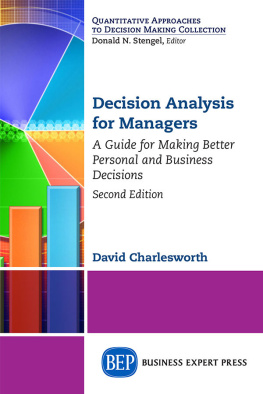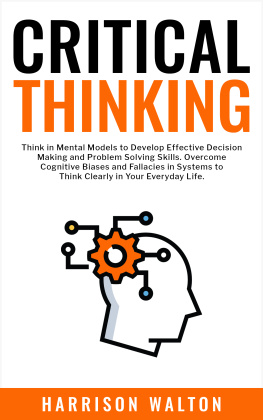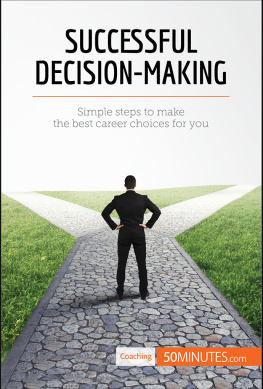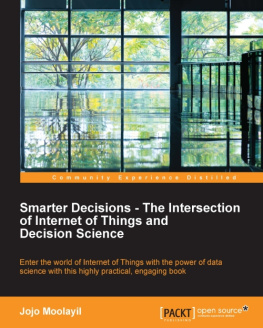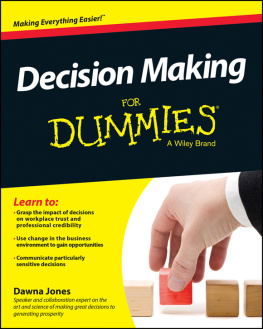Praise for Problem Solved
In my 25 years reporting on social innovation, Ive found that what distinguishes the most successful organizations is how they minimize risk, pursue opportunity, track results, and plan ahead. The AREA Method described in Problem Solved offers an accessible and systematic approach for anyone to do this: It shows how to break down complex decisions into manageable steps, and provides a disciplined method to identify key questions, reveal core assumptions, and evaluate alternativeshelping to clarify pathways and possibilities.
David Bornstein, author of How To Change The World and the New York Times Fixes Column
Effective problem-solving in our daily lives requires orderly thinking. Cheryl Einhorn shows us a way to do it in a short, clearly written book. Her lessons are organized around case studies that are free of jargon and to the point. In fact, her case studies are short novels that draw the reader into the dilemmas her characters face. They provide wonderful illustrations of how to go about making difficult decisions. Her book is a must read those of us facing major decisions about our personal and professional futures.
John Campbell, former United States Ambassador to Nigeria and currently the Ralph Bunche senior fellow for Africa policy studies at the Council on Foreign Relations
PROBLEM SOLVED
PROBLEM SOLVED
A Powerful System for Making Complex Decisions With Confidence and Conviction
Cheryl Strauss Einhorn
Foreword by Tony Blair

Copyright 2017 by Cheryl Strauss Einhorn
All rights reserved under the Pan-American and International Copyright Conventions. This book may not be reproduced, in whole or in part, in any form or by any means electronic or mechanical, including photocopying, recording, or by any information storage and retrieval system now known or hereafter invented, without written permission from the publisher, The Career Press.
PROBLEM SOLVED
Edited by Gina Schenck
Typeset by Diana Ghazzawi
Cover design by Rob Johnson/toprotype
Printed in the U.S.A.
To order this title, please call toll-free 1-800-CAREER-1 (NJ and Canada: 201-848-0310) to order using VISA or MasterCard, or for further information on books from Career Press.

The Career Press, Inc.
12 Parish Drive
Wayne, NJ 07470
www.careerpress.com
Library of Congress Cataloging-in-Publication Data
CIP Data Available Upon Request.
One day when I was a young girl, my mother went out and got her makeup done at a local department store makeup counter. When she returned, she asked my father how she looked. He replied, Dear, when I look at you I see my fantasy, not the makeup youre wearing. She wondered aloud if that meant he didnt really look at her. Even as a little girl, I realized that it meant he saw her perfectly.
My mother was always the practical one who kept a set of encyclopedias in the car so we could read and learn even en route to the supermarket. My fathers been the dreamer who saw and asked questions nobody else did.
This book is dedicated to both of my parents, who have taught me different ways of seeing.
Acknowledgments
As a young girl I loved mysteries, especially the notion of solving something, hunting for clues, and finding a trail where none was obvious. I grew up to be an investigative reporter since I couldnt be Trixie Belden. I taught factual sleuthing to many students at Columbia, never realizing that I was teaching a process and a way of thinking. Through time, it gestated and refined into a method: the AREA Method.
I still recall when I came up with the AREA acronym and who arrived at just that moment to hear about it: my dad. Hed come over for the weekly Sabbath celebration. It was perfect because he is a researcher extraordinaire and Shabbat is a time when we strategically stop each week to say thank you.
Of course, many other people were instrumental in discussing and working on this book with me.
Peter Lawrence, a former student, but now my co-teacher at Columbia and friend, was all-important in our conversations and work together.
Cathleen Barnhart, who once taught my kids and now has taught me not only about storytelling and writing but also about friendship.
To my agent Stacey Glick for believing in this book and in me, and for her guidance through the process to help it find a good home.
To other friends and colleagues who read the manuscript and shared their thoughtful, useful feedback: Dina Berrin, Tony Blair, David Bornstein, John Campbell, Jonathon Gruber, Liz Landau, Joe Platt, and Marc Skvirsky.
To John Christopher, who let me share his inspirational story, his research, and his good works, Id like to donate half of all the proceeds from this book to your Oda Foundation.
And to David, I know that saying I love you is never saying enough, but its a beginning.
For readers who would like to stay in touch, I look forward to hearing from you about how the AREA Method works for you. Please contact me through the areamethod.com website.
Disclaimer
All of the research in this book represents a snapshot in time. Websites and documents are routinely updated and information changes, so what John, Micah, Claudia, or Bill, or even I, found may not be indicative of anyone elses experience now. All of the research and decisions were made at a moment in time by one person with one set of personal Critical Concepts. You, your Critical Concepts, and the information you find will be different.
Contents
by Tony Blair
Foreword
One of the fascinating aspects of leadership is the process of decision-making. And the challenge of doing it properly is the same in any walk of lifeleading a company, a community, a country, or even a football team.
But of course in everyday life, we also make big decisions in how we lead our own lives: about what career move to make, where to live, how to handle family concerns and crises, how to identify our lifes goals, and how to meet them effectively.
How do you get the best possible chance of making them correctly? This is the subject of Cheryl Einhorns book. She believes that you can apply an analytical framework to decision-making which improves the possibility of a good outcome. I think it is a really interesting idea and the book makes it clear and simple to follow.
In essence, the method called AREA breaks down the process of making a decision, teaching you how to avoid bias and preconception which may be misconception, allowing you to define accurately the Critical Concepts at the core of the decision, which enable you to assess what is really the objective you seek to achieve and how.
It draws an analogy with the way a cheetah hunts. The key is the animals ability to decelerate and pause, giving it the opportunity to turn and change direction where necessary to pursue its prey. In the same way, when taking a critical decision, she shows how at crucial moments it pays to slow down, to re-assess, and sometimes to switch course. She suggests a methodology as to how to do it.
The AREA Method is exemplified by reference to real case studies of real lifewhich university or program to choose or how to make the right care choice for elderly parents. But the significance of the AREA way of thinking is that it can be applied to anything from politics to business to creative art.
Next page

